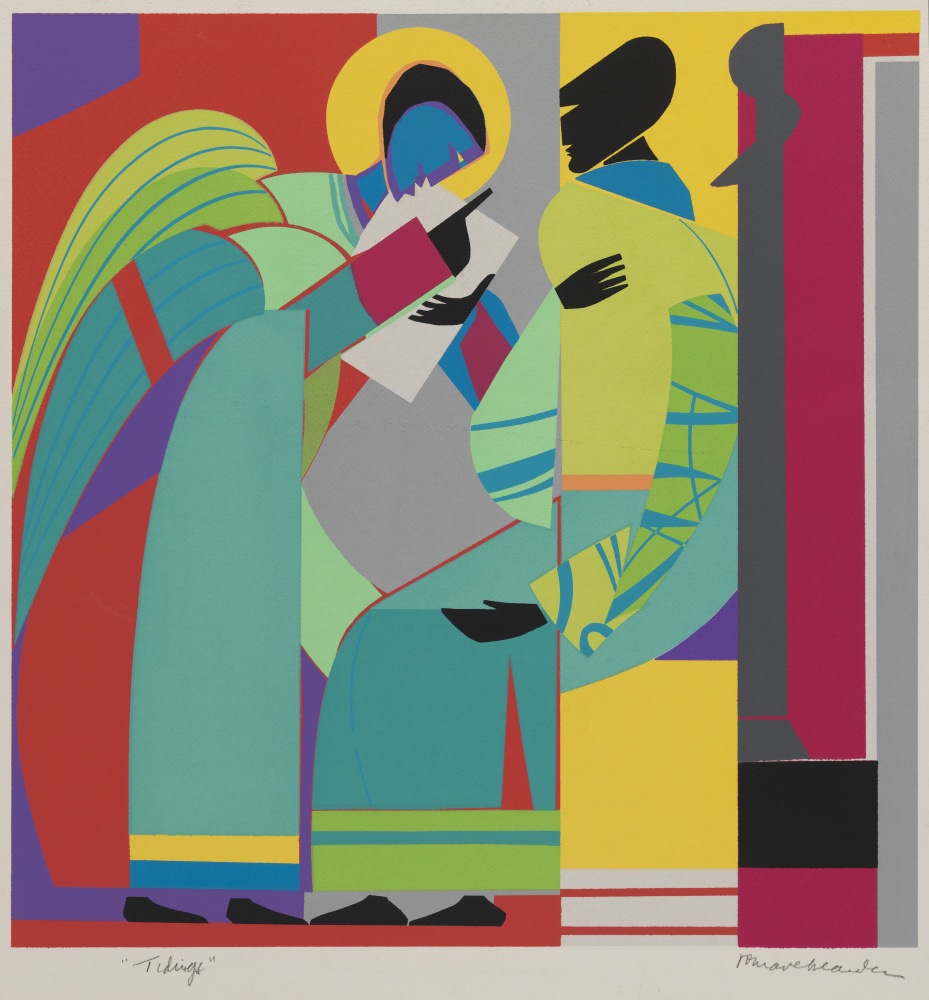- Open today, 10 am to 5 pm.
- Parking & Directions
- Free Admission
Romare Bearden’s Tidings
–Kimberli Gant, PhD, McKinnon Curator of Modern and Contemporary Art
“Tidings” isn’t a big part of everyday English language today, but the word always resurfaces during the holiday season. We find it in several beloved Christmas songs, including “We Wish You a Merry Christmas” and “God Rest Ye Merry Gentlemen.” This holiday season, you’ll find it in the Chrysler Museum’s galleries. Romare Bearden’s Tidings is featured in our special exhibition, Come Together, Right Now! The Art of Gathering.

Romare Bearden (American, 1911-1988), Tidings, ca. 1970, Screenprint on wove paper, Chrysler Museum of Art, 0.3980
In Tidings, Bearden illustrates an angel who appears to deliver important news. Presumably, this is the Annunciation story, where the Archangel Gabriel tells Mary she is to conceive and give birth to Jesus. In this abstract representation, the artist illustrates the angel with a yellow halo and wings. Without the presence of hair, it is hard to tell if the other figure is Mary. However, there is a large bulge in the stomach area, suggesting that Mary is the recipient of the news.
Tidings focuses on the notion that Gabriel’s news was joyous. The word “tidings” has a long history in relation to Christianity and Christmas. During the holiday season, a person may hear the phrase “good tidings” or “glad tidings,” meaning “good news or information.” The word also appears in Luke 2:10 of the King James Bible: “Fear not: for behold, I bring you good tidings of great joy, which shall be to all people.” The verse tells the story of an angel that comforts Mary and Joseph on the night of Jesus’ birth. Beyond Bearden’s visual interpretation of “tidings,” the word dates back to the thirteenth-century Norse word “tiðendi,” which also means “news” according to the Macmillian dictionary. It was later incorporated into Old English, with the word “tidan,” which means “to happen.”[i]
Tidings was one of several Biblical scenes Bearden created throughout his career. His most famous work from this theme is The Visitation[ii] from 1941 at the Museum of Modern Art. He depicts a quiet, intimate moment between two women. As the title suggests, it is a visitation between the Virgin Mary and her cousin Elizabeth. In older paintings of the same scene, both women are presented as either pregnant[iii] or with their children[iv]—Mary with Christ and Elizabeth with St. John the Baptist. Both pregnancies were miracles since Mary was a virgin and Elizabeth was much older and past child-bearing age.[v] In Bearden’s painting, the pregnancies are not visible and the focus is more upon the relationship between the two women.
Although Bearden devoted much of his career to presenting themes from the Bible, he was known for abstract collages of African American life. He often depicted figures in rural settings, referencing his family’s origins in North Carolina. During the Great Migration of African Americans from southern to northern states, Bearden’s parents moved him from North Carolina to New York.

Tidings on view in Come Together, Right Now through January 3, 2020
See Tidings and more than 100 other works drawn from the Chrysler Museum’s collection in Come Together, Right Now, on view through January 3. Four themes–Together in Celebration, Together in Purpose, Together in Justice, and Together in Love—display the many ways artists explore the joys and complexities of “coming together” and showcase how communities are linked by activities, celebrations, demonstrations, love, and family.
[i] https://www.macmillandictionaryblog.com/tidings
[ii] https://www.moma.org/collection/works/180915?classifications=any&date_begin=Pre-1850&date_end=2020&q=Romare+Bearden&utf8=%E2%9C%93&with_images=1
[iii] https://www.wga.hu/html_m/w/weyden/rogier/17other/3visitat.html
[iv] https://chrysler.emuseum.com/objects/10893/holy-virgin-and-child-elizabeth-and-saint-john?ctx=7ac0fc08-cf77-45c9-be5f-f4fd3bdf3786&idx=0
[v] https://www.moma.org/explore/inside_out/2015/04/22/a-homecoming-for-romare-beardens-the-visitation/

